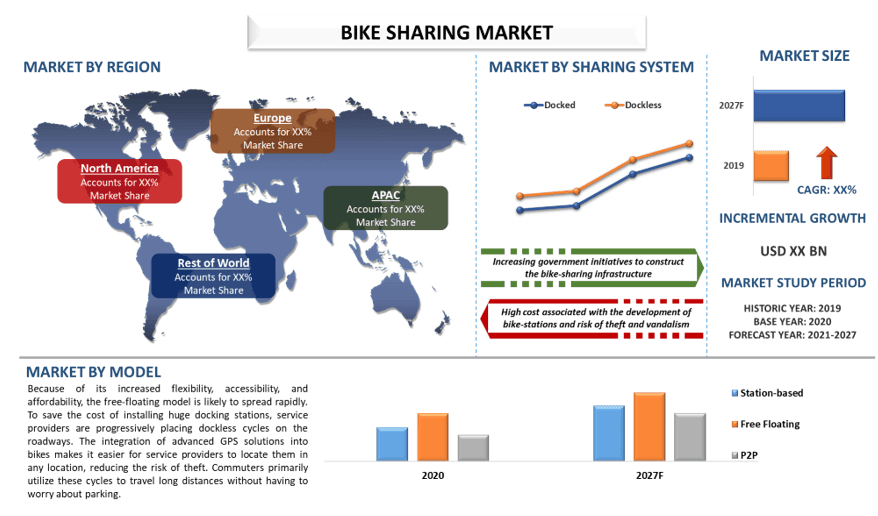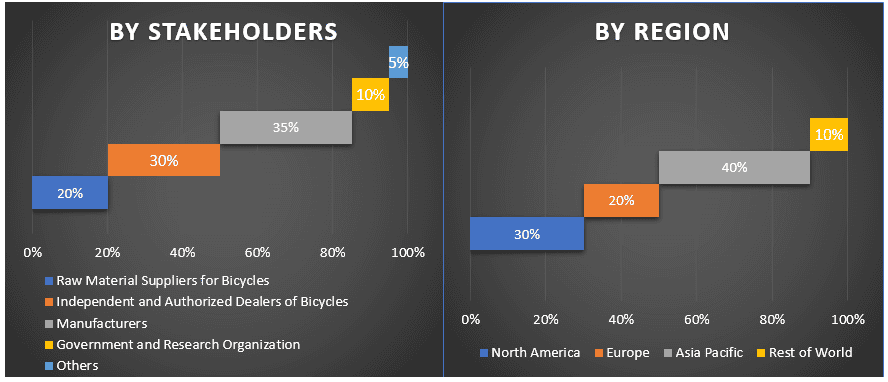- Home
- About Us
- Industry
- Services
- Reading
- Contact Us
Bike Sharing Market: Current Analysis and Forecast (2021-2027)
Emphasis on Bike Type (Traditional Bike and E-Bike); Sharing System (Docked and Dockless); Model (Station-based, Free Floating, and P2P); Region and Country

Global Bike Sharing is anticipated to display a CAGR of around ~12% over the forecast period (2021-2027). Governments all over the world are supporting e-bikes and taking various efforts to encourage their use. Developing countries, such as China and India, are driving the e-bike market. China, for example, is the world’s largest e-bike market. China has traditionally been the world’s top exporter of electric motorcycles, with high import and export volumes. China’s Ministry of Industry and Information Technology reports that during the first 10 months of 2020, the nation’s production of electric bicycles increased by 33.4 percent year over year, reaching 25.48 million units. The income of major bicycle manufacturing companies reached around USD 22 billion during this time, an increase of 16.8%. E-bikes are becoming more popular around the world as a result of their quick and flexible operation and zero carbon emissions. The growing popularity of e-bikes as a cost-effective and environmentally responsible mode of transportation is fueling the growth of the bike-sharing industry. The company’s expansion is likely to be aided by increased spending in R&D operations aimed at improving battery performance and improving bicycle infrastructure. Commuters mostly use these cycles for hill climbing and carrying big goods, both of which require manual pedaling. Bike-sharing companies in North America and Europe are replacing traditional bikes with e-bikes to give their customers more reliable and efficient service.
Insights Presented in the Report
“Amongst Bike Type, E-Bike segment to be most lucrative”
Based on bike type, the market is segmented into Traditional Bike and E-Bike. The E-Bike segment is projected to be the most lucrative segment, as e-bikes are becoming more popular around the world as a result of their quick and flexible operations and zero carbon emissions. In addition, an increase in consumer interest in using e-bikes as a cost-effective and environmentally responsible mode of transportation is fueling the growth of bike sharing. Furthermore, when compared to a pedal-operated bike, an e-bike is a much-favored option because it meets the criteria for higher speed in short-distance commuting. Higher speeds, greater convenience, effortless driving, and changing motor power based on road conditions all contribute to the popularity of e-bikes for sharing. Furthermore, governments all around the world are promoting the use of e-bikes through various projects
“Amongst sharing system, Dockless segment dominated the market in 2020.”
Based on sharing system, the market is segmented into Docked and Dockless. Over the anticipated period, the dockless segment is expected to develop at a healthy rate. Due to technical advancements, dockless electric bike-sharing products have been introduced, which enable improved bike-sharing services and convenience of transit access by allowing customers to pick up and drop off bikes at any lawful public vehicle parking instead of the operator’s bike stations. The number of dockless electric bikes on the market is increasing. Uber, for example, introduced its dockless electric bikes in London in May 2019. The dockless bikes have baskets and phone mounts, as well as an electric pedal system that delivers up to 15 miles per hour of assistance
“Amongst Model, Free Floating segment dominated the market in 2020”
Based on the model, the market is segmented into Station-based, Free Floating, and P2P. Because of its increased flexibility, accessibility, and affordability, the free-floating model is likely to spread rapidly. To save the cost of installing huge docking stations, service providers are progressively placing dockless cycles on the roadways. The integration of advanced GPS solutions into bikes makes it easier for service providers to locate them in any location, reducing the risk of theft. Commuters primarily utilize these cycles to travel long distances without having to worry about parking. For returning the bike to a designated parking place, several service providers, such as LimeBike and oBike, offer credit points. Increasing traffic congestion in cities is encouraging commuters to use free-floating options rather than station-based options
“Asia Pacific represents the largest market.”
From 2021 to 2027, the Asia Pacific bike sharing market is estimated to grow significantly. Due to changing consumer preferences for energy-efficient transportation solutions, the industry is experiencing rapid expansion in the region. China has over 70 bike-sharing organizations, according to the Ministry of Transport (MoT), with 23 million bicycles and over 400 million customers across the country. Industry expansion is aided by urbanization and a rapidly growing population in India and China. Due to the vast number of prospective clients in the region, several start-ups are investing in the Chinese market. Furthermore, around 30 Chinese cities, including Shanghai and Beijing, have enacted a number of regulations to guide bike-sharing maintenance, operation, and production, allowing service providers to remove broken bikes from the fleet. For example, in August 2017, China issued a national framework for regulating dockless bike-sharing to guarantee that bikes are distributed evenly and that specified parking spaces are available. Some of the major players operating in the market include Lyft, Inc., Uber Technologies, Inc., Neutron Holdings Inc., Meituan, Dropbike Inc., JCDecaux Group, Mobike, Motivate LLC, Jump Bicycles and Nextbike Berlin etc.
Reasons to buy this report:
- The study includes market sizing and forecasting analysis validated by authenticated key industry experts
- The report presents a quick review of overall industry performance at one glance
- The report covers an in-depth analysis of prominent industry peers with a primary focus on key business financials, product portfolio, expansion strategies, and recent developments
- Detailed examination of drivers, restraints, key trends, and opportunities prevailing in the industry
- The study comprehensively covers the market across different segments
- Deep dive regional & country-level analysis of the industry
Customization Options:
The Global Bike Sharing can further be customized as per the requirement or any other market segment. Besides this, UMI understands that you may have your own business needs, hence feel free to connect with us to get a report that completely suits your requirements.
Table of Content
The modern world heavily depends on mobility. Governments and international organizations throughout the world are establishing strict emission rules to reduce carbon emission levels, albeit this is due to the ongoing growth of environmental and health concerns as well as rising emission levels. Governments and society are faced with a formidable issue as a result of the alarming rate at which fossil fuel levels are being depleted. E-bikes are proven to be the perfect answer to the problem as a result. The ideal form of mobility is increasingly e-bikes, particularly pedelecs. Pedelecs are reliable and environmentally friendly e-bikes. For instance, an e-bike seller named HumanForest raised GBP 1.3 million through a crowdfunding campaign in December 2020. A sustainable e-bike service will be made available in cities by the London-based HumanForest, beginning in the spring with London and then spreading around Europe. With 200 e-bikes, HumanForest tested this service throughout the summer, and it intends to use the most recent funding to increase the fleet to 1,500 e-bikes.
Seek More Details About Research Methodology
The primary use of bike sharing is for short-distance excursions because it is both affordable and practical. Sharing bikes is an environmentally responsible way to travel because it is a relatively clean form of transportation. Rental services and leisure activities are the main uses for these kinds of facilities. Hybrid, free-floating, freight, and dock-based bike-sharing are only a few examples of several bike-sharing schemes. Growing adoption of electric bikes along with increased collaboration between mobility as a service providers and bike sharing firms is anticipated to fuel industry expansion. Additionally, increased comfort and speed over short distances are anticipated to boost market expansion. However, some of the main obstacles are the increase in bike theft, vandalism, and costly initial investment costs are impacting the market growth. Increased demand for urban mobility has led to a rise in the number of vehicles, particularly two-wheelers and passenger cars, which has resulted in both high traffic congestion and noise pollution. The governments of various nations, including India, China, and Germany, are promoting bicycle sharing programs by creating road infrastructure that is specifically suited for bicycle use in an effort to lessen the aforementioned problems.
Analysis of Historical Market Size
Step 1: In-Depth Study of Secondary Sources:
A detailed secondary study was conducted to obtain the historical market size of the Bike Sharing through company internal sources such as annual reports & financial statements, performance presentations, press releases, etc., and external sources including journals, news & articles, government publications, competitor publications, sector reports, third-party database, and other credible publications.
Step 2: Market Segmentation:
After obtaining the historical market size of the Bike Sharing, we conducted a detailed secondary analysis to gather historical market insights and share for different segments & sub-segments for major regions. Major segments included in the report are bike type, sharing system, and model. Further regional & country-level analyses were conducted to evaluate the overall adoption of Bike Sharing in the global context.
Step 3: Factor Analysis:
After acquiring the historical market size of different segments and sub-segments, we conducted a detailed factor analysis to estimate the current market size. Further, we conducted factor analysis using dependent and independent variables such as growing government incentives and demand for eco-friendly transportation, etc. Historical trends and their year-on-year impact on the market size and share were analyzed. Demand and the supply-side scenario were also thoroughly studied.
Current Market Size Estimate & Forecast
Current Market Sizing: Based on actionable insights from the above 3 steps, we arrived at the current market size, key players in the market, and market shares of the segments and company. All the required percentage split and market breakdowns were determined using the above-mentioned secondary approach and were verified through primary interviews.
Estimation & Forecasting: For market estimation and forecast, weights were assigned to different factors including drivers & trends, restraints, and opportunities available for the stakeholders. After analyzing these factors, relevant forecasting techniques i.e., the bottom-up approach were applied to arrive at the market forecast to 2027 for different segments and subsegments across the major regions globally. The research methodology adopted to estimate the market size encompasses:
- The industry’s market size, in terms of value (US$) and the adoption rate of Bike Sharing across the major markets
- All percentage shares, splits, and breakdowns of market segments and sub-segments
- Key players in Bike Sharing in terms of products offered. Also, the growth strategies adopted by these players to compete in the fast-growing market.
Market Size and Share Validation
Primary Research: In-depth interviews were conducted with the Key Opinion Leaders (KOLs) including Top Level Executives (CXO/VPs, Sales Head, Marketing Head, Operational Head, Regional Head, Country Head, etc.) across major countries. Primary research findings were then summarized, and statistical analysis was performed to prove the stated hypothesis. Inputs from primary research were consolidated with secondary findings, hence turning information into actionable insights.
Split of Primary Participants in Different Regions

Market Engineering
The data triangulation technique was employed to complete the overall market estimation and to arrive at precise statistical numbers for each segment and sub-segment of the Bike Sharing. Data was split into several segments & sub-segments post studying various parameters and trends in the areas of application, vehicle type, component, and region.
The main objective of the Bike Sharing Study
The current & future market trends of Bike Sharing were pinpointed in the study. Investors can gain strategic insights to base their discretion for investments on the qualitative and quantitative analysis performed in the study. Current and future market trends would determine the overall attractiveness of the market at a regional & country level, providing a platform for the industrial participant to exploit the untapped market to benefit as a first-mover advantage. Other quantitative goals of the studies include:
- Analyze the current and forecast market size of Bike Sharing in terms of value (US$). Also, analyze the current and forecast market size of different segments and sub-segments
- Segments in the study bike type, sharing system, and model
- Defined analysis of the regulatory framework for the Global Bike Sharing industry
- Analyze the value chain involved with the presence of various intermediaries, along with analyzing customer and competitor behaviors of the industry
- Analyze the current and forecast market size of the Bike Sharing for the major regions & countries
- Major regions studied in the report include North America (US, Canada, Rest of North America), Europe (Germany, United Kingdom, France, Italy, and Rest of Europe), Asia Pacific (China, Japan, India, South Korea, Rest of Asia-Pacific), and Rest of World
- Company profiles of the Bike Sharing players and the growth strategies adopted by them to sustain in the fast-growing market
Deep dive regional & country-level analysis of the industry
Related Reports
Customers who bought this item also bought










